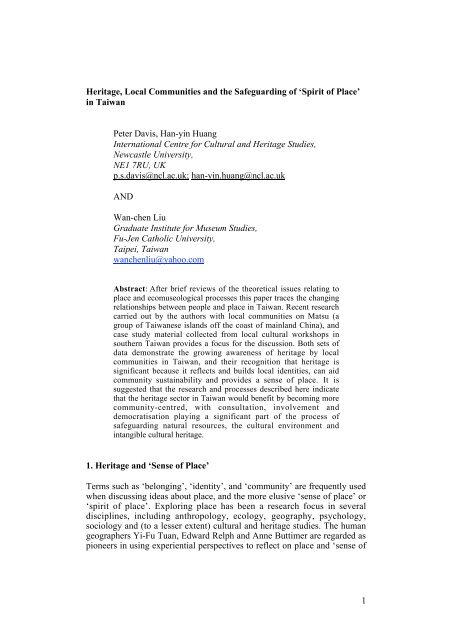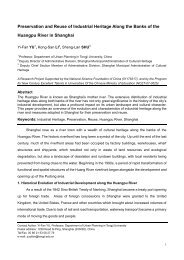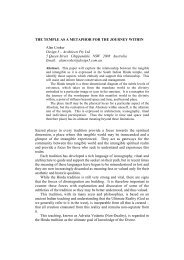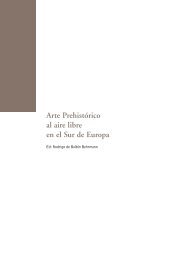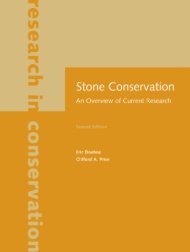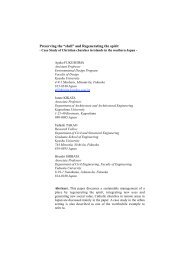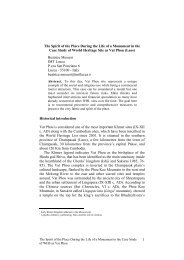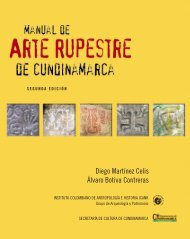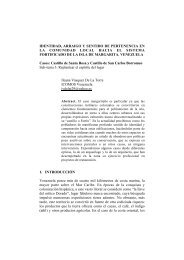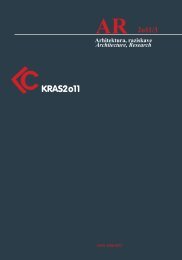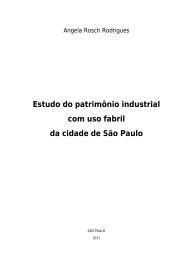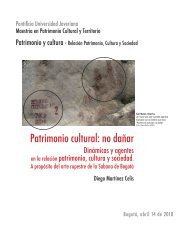'Spirit of Place' in Taiwan - ICOMOS Open Archive
'Spirit of Place' in Taiwan - ICOMOS Open Archive
'Spirit of Place' in Taiwan - ICOMOS Open Archive
Create successful ePaper yourself
Turn your PDF publications into a flip-book with our unique Google optimized e-Paper software.
conserve and <strong>in</strong>terpret scattered fragments <strong>of</strong> heritage us<strong>in</strong>g <strong>in</strong>clusive anddemocratic approaches is the ecomuseum.2. Ecomuseums: democratic approaches to heritage, place and identityThe theories discussed above support the view that ecomuseums – assignifiers <strong>of</strong> place – can have important mean<strong>in</strong>gs for visitors and localpeople. The ecomuseum paradigm, its orig<strong>in</strong>s, development and diversityhas been described by Davis (1999). In 2004 the ‘Long Network’ <strong>of</strong>ecomuseums developed <strong>in</strong> Europe def<strong>in</strong>ed the ecomuseum as ‘… a dynamicway <strong>in</strong> which communities preserve, <strong>in</strong>terpret, and manage their heritage forsusta<strong>in</strong>able development. An ecomuseum is based on a communityagreement’ (Declaration <strong>of</strong> Intent <strong>of</strong> the Long Net Workshop, Trento (Italy),May 2004). Davis (2007, 119) further simplified this def<strong>in</strong>ition, stat<strong>in</strong>g thatan ecomuseum is ‘a community-lead heritage or museum project thatsupports susta<strong>in</strong>able development’.Essential ecomuseum features are: The adoption <strong>of</strong> a territory that may be def<strong>in</strong>ed, for example, bylandscape, dialect, a specific <strong>in</strong>dustry, or musical tradition. The identification <strong>of</strong> specific heritage resources with<strong>in</strong> thatterritory, and the celebration <strong>of</strong> these ‘cultural touchstones’ us<strong>in</strong>g<strong>in</strong>-situ conservation and <strong>in</strong>terpretation. The conservation and <strong>in</strong>terpretation <strong>of</strong> <strong>in</strong>dividual sites with<strong>in</strong> theterritory is carried out via liaison and co-operation with otherorganisations. The empowerment <strong>of</strong> local communities – the ecomuseum isestablished and managed by local people. Local people decidewhat aspects <strong>of</strong> their ‘place’ are important to them. The local community benefits from the establishment <strong>of</strong> theecomuseum. Benefits may be <strong>in</strong>tangible, such as greater selfawarenessor pride <strong>in</strong> place, tangible (the rescue <strong>of</strong> a fragment <strong>of</strong>local heritage, for example) or economic. There are <strong>of</strong>tensignificant benefits for those <strong>in</strong>dividuals <strong>in</strong> the local communitymost closely associated with ecomuseum development (Corsaneet al. 2007a and 2007b).These features <strong>in</strong>dicate the strong connection between ecomuseums andspecific geographical localities, with the latter two po<strong>in</strong>ts demand<strong>in</strong>g thatecomuseums embrace local empowerment and heed local voices. Therehave been some attempts to utilise aspects <strong>of</strong> the above features <strong>in</strong> <strong>Taiwan</strong>,for example the Gold Ecological Park uses a ‘split-site’ approach to<strong>in</strong>terpretation. More recently ecomuseum processes have been used at thefish<strong>in</strong>g village <strong>in</strong> Nan Fang Ao <strong>in</strong> Yilan County <strong>in</strong> eastern <strong>Taiwan</strong> <strong>in</strong> aneffort to prevent economic decl<strong>in</strong>e by def<strong>in</strong><strong>in</strong>g heritage features <strong>in</strong> thelandscape (Chiao 2007). These <strong>in</strong>clusive processes <strong>in</strong> the implementation <strong>of</strong>Heritage, local communities and the safeguard<strong>in</strong>g <strong>of</strong> ‘Spirit <strong>of</strong> Place’ <strong>in</strong><strong>Taiwan</strong>3
ecomuseums have, to some extent, also been utilised <strong>in</strong> <strong>Taiwan</strong>’s ‘localcultural workshops’ and other heritage preservation activities emerg<strong>in</strong>g onthe islands <strong>of</strong> Matsu. These projects are described below.3. Local voices: <strong>Taiwan</strong>’s Local Cultural WorkshopsIn 1993, the Council for Cultural Affairs (CCA), <strong>Taiwan</strong>’s centralgovernment agency <strong>in</strong> charge <strong>of</strong> cultural issues, published a report on<strong>Taiwan</strong>’s contemporary cultural services and facilities, and addressed theissues <strong>of</strong> the lack <strong>of</strong> local community <strong>in</strong>volvement <strong>in</strong> cultural developmentand the failure <strong>of</strong> the authorities and local communities to co-operate. Thereport proposed a stronger l<strong>in</strong>k between the local cultural authorities andlocal people <strong>in</strong> order to <strong>in</strong>tegrate and make best use <strong>of</strong> exist<strong>in</strong>g culturalresource (CCA 1999a). The CCA then (1993) <strong>in</strong>troduced the CommunityRenaissance scheme, aspir<strong>in</strong>g to encourage residents’ <strong>in</strong>volvement <strong>in</strong> localaffairs through group discussion.An understand<strong>in</strong>g <strong>of</strong> local history and culture became a basic role <strong>of</strong>Community Renaissance. When this scheme was launched, its emphasis on‘bottom-up’ approaches meant that the knowledge held by local culturalworkers - useful <strong>in</strong>formation about local character and local dist<strong>in</strong>ctiveness– would be utilised (Cultural Environment Workshop 2000). Policiesaccompany<strong>in</strong>g the Community Renaissance scheme could hence be built onthis <strong>in</strong>formation <strong>in</strong> order to meet the demands and real needs <strong>of</strong> the locality.Perhaps without realis<strong>in</strong>g it, moves were be<strong>in</strong>g made to implement moredemocratic ecomuseological processes, and use ‘territorial’ approaches.The appeal for <strong>in</strong>digenisation promoted by the government at this time,(i.e. the promotion <strong>of</strong> a dist<strong>in</strong>ctive ‘<strong>Taiwan</strong>ese’ culture), required actionfrom the grassroots. The rise and development <strong>of</strong> local cultural workshops<strong>in</strong> <strong>Taiwan</strong> was such a response, promot<strong>in</strong>g the development <strong>of</strong> a sense <strong>of</strong>cultural ownership. ‘Workshop’, <strong>in</strong> Mandar<strong>in</strong> Ch<strong>in</strong>ese, means that an<strong>in</strong>dividual or a group <strong>of</strong> people, with the same <strong>in</strong>terest and target, <strong>in</strong>volved<strong>in</strong> work which require pr<strong>of</strong>essional knowledge and skills (MoE 1997).While it is similar to the use <strong>of</strong> ‘workshop’ <strong>in</strong> the English language, itimplies a long-term and dist<strong>in</strong>ct organisation, rather than a short-termexercise that feeds <strong>in</strong>to other, more major activities. Local CulturalWorkshops are def<strong>in</strong>ed here as voluntary community groups that operateover a long period to deal with cultural issues at the grassroots level.However, not all the local cultural workshops adopt the title ‘workshop’;some larger groups with better f<strong>in</strong>ancial and personnel support use the terms‘associations’ or ‘foundations’. The ways workshops are managed also varyhugely dependant on their f<strong>in</strong>ancial situation. Income is derived frommembership fees <strong>in</strong> the case <strong>of</strong> larger groups, or they receive fund<strong>in</strong>g fromdifferent levels <strong>of</strong> government. Such support can come from workshopspropos<strong>in</strong>g their own projects or by tak<strong>in</strong>g advantage <strong>of</strong> an exist<strong>in</strong>ggovernment scheme.Peter Davis, Han-y<strong>in</strong> Huang and Wan-chen Liu 4
There are several dimensions to the term ‘local cultural workshop’.‘Local’ does not always refer to the workshops’ geographically def<strong>in</strong>edlocations, but more <strong>of</strong>ten <strong>in</strong>dicates the level <strong>of</strong> issues dealt with by the localcultural workshops, ‘which is native, emotional, grassroots, and nongovernmental’(Chen, quoted <strong>in</strong> T<strong>in</strong>g 2001, 10). ‘Cultural’ describes thetype <strong>of</strong> activities <strong>in</strong>volved, but these can be very varied.One example is the S<strong>in</strong>-hua Local Cultural Workshop, whose director,Mr Jhong, is a retired school headmaster. He started do<strong>in</strong>g fieldwork <strong>in</strong>relation to his teach<strong>in</strong>g roles and developed a great <strong>in</strong>terest <strong>in</strong> local history.He now organises day trips for local residents to <strong>in</strong>terpret different aspects<strong>of</strong> the heritage <strong>of</strong> the town. Accord<strong>in</strong>g to Jhong (<strong>in</strong>terview: 29/03/2006),‘although they are local people, frankly speak<strong>in</strong>g their understand<strong>in</strong>g <strong>of</strong>Hs<strong>in</strong>-hua is limited to the town centre… they’ve never paid much attentionto other parts, even when they walk past, they’ve never paid any attention’.The tour <strong>in</strong>cludes historic streets, local temples, and the scenic areas on theoutskirts <strong>of</strong> the town that are rich <strong>in</strong> wildlife. The participants, Jhongdescribed, ‘were surprised that “why haven’t I seen these before?”’ Theseactivities engage local residents with know<strong>in</strong>g and learn<strong>in</strong>g about their ownplace and promote a sense <strong>of</strong> pride <strong>in</strong> their town.It was not until 1987, when martial law was no longer enforced on theisland, that grassroots groups were able to make a significant impact (CCA1999a). However, <strong>in</strong> spite <strong>of</strong> these restrictions the first organization thatresembled a local cultural workshop was the Ta<strong>in</strong>an Culture and HistoryAssociation <strong>in</strong> Ta<strong>in</strong>an City, founded <strong>in</strong> 1957. A prelim<strong>in</strong>ary survey <strong>of</strong> localcultural workshops, us<strong>in</strong>g questionnaires, <strong>in</strong>terviews with government<strong>of</strong>ficials and sem<strong>in</strong>ars, was conducted by the CCA over the period July 1998to June 1999. Its aim was to assess difficulties they faced and to seeksolutions. The survey identified that the development <strong>of</strong> local culturalworkshops had occurred <strong>in</strong> three stages, 1957-1988, 1989-1992, and 1992-1999. The growth <strong>of</strong> local cultural workshops was very limited until 1988,but grew rapidly <strong>in</strong> the second period. The vast majority <strong>of</strong> local culturalworkshops emerged from 1993; accord<strong>in</strong>g to the survey, there were at leastthirty workshops set up every year and at least one every month dur<strong>in</strong>g thistime (CCA 1999b). The bottom-up approaches that Community Renaissanceboasts and promotes, however, were not necessarily realised <strong>in</strong> all projects.Critics <strong>of</strong> Community Renaissance argue that it is still essentially a topdownmeasure with which the government seek to create an imag<strong>in</strong>edcommunity that aligns with its preferred image <strong>of</strong> national identity (Huang1995).The Prelim<strong>in</strong>ary Survey <strong>of</strong> Local Cultural Workshops (CCA 1999b)suggests that the growth <strong>of</strong> local cultural workshops can be attributed togovernment policy changes, the grow<strong>in</strong>g importance <strong>of</strong> the study <strong>of</strong><strong>Taiwan</strong>’s history and the grow<strong>in</strong>g pace <strong>of</strong> cultural development. ResearchHeritage, local communities and the safeguard<strong>in</strong>g <strong>of</strong> ‘Spirit <strong>of</strong> Place’ <strong>in</strong><strong>Taiwan</strong>5
y one <strong>of</strong> the above authors (HYH) <strong>in</strong>dicates that workshop activistsidentify 1993 as a milestone <strong>of</strong> the development <strong>of</strong> local cultural workshops<strong>in</strong> <strong>Taiwan</strong>. Jhiang, president <strong>of</strong> the Kia-a-tao LCW, spoke <strong>of</strong> thephenomenon <strong>of</strong> rapid rise <strong>in</strong> numbers <strong>of</strong> workshops:‘That was to make up for the problem resulted fromthe long-term loose attachment to place and the issue<strong>of</strong> place identity. As soon as such motivationappeared, there were more or less a thousandworkshops at its peak’ (Jhiang: Kia-a-taoAssociation, 08/03/2006)The presentation <strong>of</strong> a local community’s voice is at the heart <strong>of</strong> thedemocratic approaches taken by museums and heritage sector (Davis 2004).To local people, the place where they belong conta<strong>in</strong>s memories they share;to visitors, the place they are visit<strong>in</strong>g expresses messages from the local,contrast<strong>in</strong>g with their known experience, their own place. When it is appliedto heritage preservation, sense <strong>of</strong> place is felt <strong>in</strong>-situ. Examples <strong>of</strong>communities tak<strong>in</strong>g <strong>in</strong>itiatives to achieve their own agendas by mak<strong>in</strong>g use<strong>of</strong> the available museum and heritage resources have been explored byCrooke (2005). However, <strong>Taiwan</strong>’s heritage sector has long been dom<strong>in</strong>atedby experts <strong>in</strong> the discipl<strong>in</strong>es <strong>of</strong> architecture and plann<strong>in</strong>g (Yen 2006), withlittle scope for democratic decision-mak<strong>in</strong>g.As a consequence the heritage focus has <strong>in</strong> the past fallen onarchitectural values - especially its aesthetic value - rather than the relevanceor mean<strong>in</strong>g <strong>of</strong> sites and build<strong>in</strong>gs to the wider community. Riley andHarvey’s (2005) critique <strong>of</strong> over-reliance on expert-led knowledgeconstruction and distribution argues for the community to be taken <strong>in</strong>toconsideration. Comments from local community workshop activists echothese arguments, demand<strong>in</strong>g the community’s <strong>in</strong>terpretation <strong>in</strong> order tomore fully understand the local context. In particular there appears to be atension between the <strong>in</strong>terpretation <strong>of</strong> local people and that <strong>of</strong> the academichistorians. While folk stories and legends are well known among localpeople, they may not necessarily conform to what historians understand orbelieve. An example <strong>of</strong> this phenomenon is the town <strong>of</strong> Sia-y<strong>in</strong>g <strong>in</strong> South<strong>Taiwan</strong>, which used to be a busy port, but the river silted up and the portwas no longer viable. The town’s fortunes changed and it has become arelatively quiet area. Ignor<strong>in</strong>g the silted port and its impact on the town’slong gone prosperity the local people have developed their ownexplanations for these changes which are different from that <strong>of</strong> academichistorians. Accord<strong>in</strong>g to the local cultural workshop Hai-chian-y<strong>in</strong>g(<strong>in</strong>terview: 30/03/2006), a local saga attributed the change <strong>of</strong> the town’sfortune to the conf<strong>in</strong>ement <strong>of</strong> a local deity for her wrong-do<strong>in</strong>g <strong>in</strong> anearthquake. These localized versions <strong>of</strong> historical events appear to reflectthe local people’s own disappo<strong>in</strong>tment <strong>in</strong> the path that the past has taken,their fear to admit to their current circumstances and the anxiety anduncerta<strong>in</strong>ty over their own identities. However, such <strong>in</strong>terpretations shouldPeter Davis, Han-y<strong>in</strong> Huang and Wan-chen Liu 6
not be quickly dismissed as false history, or irrelevant, but be seen asalternative histories.Local cultural workshops’ participation <strong>in</strong> heritage projects illustratesthe possible <strong>in</strong>puts <strong>of</strong> grassroots-<strong>in</strong>itiated <strong>in</strong>terpretations to the traditionallybureaucratic and expert-dom<strong>in</strong>ated heritage practice <strong>in</strong> <strong>Taiwan</strong>. Though it isimportant to bear <strong>in</strong> m<strong>in</strong>d that local accounts or local understand<strong>in</strong>gs maynot always resemble the histories or theories recognised <strong>in</strong> academia, theynevertheless reveal the <strong>in</strong>ner pictures <strong>of</strong> the community that non-communitymembers may f<strong>in</strong>d difficult to grasp. The materials and subjects that localcultural workshops have been collect<strong>in</strong>g and study<strong>in</strong>g cover the vernacularand the <strong>in</strong>tangible; for example, the lives and experiences <strong>of</strong> retired WWIIsoldiers <strong>in</strong> nurs<strong>in</strong>g homes is a major project for the Yuan-jiao Association.Local Cultural workshops are able to capture a more democratiseddef<strong>in</strong>ition <strong>of</strong> heritage, one that may not represent the grandeur andmagnificence <strong>of</strong> elite society, but does have significant associations withlocal life, the local heritage that people can easily relate to from their ownlife experiences.4. Local voices: heritage and communities on MatsuThe Matsu Island Cha<strong>in</strong> is comprised <strong>of</strong> 26 ma<strong>in</strong> islands <strong>in</strong> the northwest <strong>of</strong>the <strong>Taiwan</strong> Strait. Be<strong>in</strong>g geographically close to ma<strong>in</strong>land Ch<strong>in</strong>a, Matsuacted as an important defence base, the front l<strong>in</strong>e aga<strong>in</strong>st communist<strong>in</strong>cursion, from 1949. Only after its mission as a military <strong>in</strong>stallation ceased<strong>in</strong> 1992 was the mysterious veil <strong>of</strong> Matsu gradually raised. S<strong>in</strong>ce that time,the abundant cultural features and ecological resources have been activelydeveloped for ecotourism and cultural tourism.The follow<strong>in</strong>g account focuses on Tisban, a small village located onNangan Island <strong>in</strong> the central section <strong>of</strong> the Matsu archipelago. The localresidents, as <strong>in</strong> many villages <strong>in</strong> Matsu fac<strong>in</strong>g rapid social change, haveattempted to redevelop their village and attract tourists, identify<strong>in</strong>g andcapitalis<strong>in</strong>g on their cultural and natural assets. They have followed the<strong>in</strong>clusive <strong>ICOMOS</strong> (2008) def<strong>in</strong>ition that ‘Heritage is a broad concept and<strong>in</strong>cludes the natural as well as the cultural environment. It encompasseslandscapes, historic places, sites and built environments, as well asbiodiversity, collections, past and cont<strong>in</strong>u<strong>in</strong>g cultural practices, knowledgeand liv<strong>in</strong>g experiences’. In order to understand how heritage was recognizedby local people, supported local identities and aided village susta<strong>in</strong>abilityfield research <strong>in</strong> Tisban village was conducted <strong>in</strong> March 2007 by two <strong>of</strong> theauthors (PD and WL) with the help <strong>of</strong> 18 graduate students. It was feltimportant to listen to local people’s views, and the pr<strong>in</strong>cipal method was<strong>in</strong>dividual <strong>in</strong>terviews supported by observation.Although <strong>of</strong>ficial documents <strong>in</strong>dicated there were 92 families (500people) <strong>in</strong> Tisban village, our research <strong>in</strong>dicated a decl<strong>in</strong><strong>in</strong>g population <strong>of</strong>some 50 families, a resident population <strong>of</strong> only 200 people. Dur<strong>in</strong>g 22 - 24March 2007 local people from 36 <strong>of</strong> these families were <strong>in</strong>terviewed byHeritage, local communities and the safeguard<strong>in</strong>g <strong>of</strong> ‘Spirit <strong>of</strong> Place’ <strong>in</strong><strong>Taiwan</strong>7
esearchers, us<strong>in</strong>g semi-structured questions. The focus <strong>of</strong> these questionsrelated to what they conceive their ‘heritage’ to be and why they felt it wasimportant. Also <strong>of</strong> <strong>in</strong>terest was how local cultural identity was perceived bydifferent generations and whether or not <strong>in</strong>dividuals engaged <strong>in</strong> communityaffairs, such as the local community park and development <strong>of</strong> a newcommunity centre.Heritage was identified with traditional hous<strong>in</strong>g by most <strong>of</strong> the<strong>in</strong>terviewees. There was a widespread general concern about the loss <strong>of</strong> thisarchitecture, which utilises local stone. Fears that many older houses hadfallen <strong>in</strong>to disrepair were compounded by the noticeable decl<strong>in</strong>e <strong>in</strong>associated craft skills. Overall there appeared to be a lack <strong>of</strong> self-confidenceamongst local residents about their heritage resources. This is <strong>in</strong> markedcontrast to the views <strong>of</strong> heritage ‘activists’ <strong>in</strong> the village, who haveattempted to capitalise on them. These village leaders have identified manyunique natural and cultural resources <strong>in</strong> Tisban village with significantpotential to attract tourists. These <strong>in</strong>clude the vernacular architecturementioned above, the small scale <strong>of</strong> the streets, a local temple and historicalsites relat<strong>in</strong>g to the area’s long military history. There are also significantnatural resources, with fasc<strong>in</strong>at<strong>in</strong>g geology, endemic plants and richwoodland flora, habitats that support a wide range <strong>of</strong> <strong>in</strong>vertebrates andbirds. The people <strong>of</strong> the village are arguably its greatest asset, with theirlocal craft and cookery skills, a fasc<strong>in</strong>at<strong>in</strong>g local dialect, the village religiousbeliefs and a very welcom<strong>in</strong>g atmosphere. Attempts have been made tosusta<strong>in</strong> attractive local vegetable gardens, document the village’s fish<strong>in</strong>ghistory, and preserve <strong>in</strong>tangible heritages such as drumm<strong>in</strong>g. Together theseresources could be <strong>in</strong>terpreted as a multi-site ecomuseum, encourag<strong>in</strong>gvisitors to experience the village <strong>in</strong> a more holistic fashion. Strangely, theefforts made by village leaders, and ecomuseum potential, appear not tohave been embraced by all residents.This field study revealed many hidden problems and challenges, <strong>in</strong>particular how to utilise processes that will enable the democraticrepresentation <strong>of</strong> local heritage, ensur<strong>in</strong>g co-operation between localresidents and outside specialists. There was, for example, tension betweendifferent ethnic groups and even between people who had settled <strong>in</strong> Tisbanfrom different villages. There appeared to be little knowledge <strong>of</strong> howheritage projects were funded, especially <strong>in</strong> relation to other communityneeds, and how they might provide employment; overall communicationappeared to be a major issue. There was a noticeable difference <strong>in</strong> op<strong>in</strong>ionabout the role <strong>of</strong> tourism, and whether this should be purely to develop thelocal economy or whether it should be carried out <strong>in</strong> a susta<strong>in</strong>able andenvironmentally-friendly fashion. Many <strong>of</strong> the residents appeared contentwith their lives and did not want to see change.International charters for conservation and restoration such as TheVenice Charter <strong>in</strong> 1964 and The Nara Document <strong>in</strong> Authenticity <strong>in</strong> 1999Peter Davis, Han-y<strong>in</strong> Huang and Wan-chen Liu 8
have suggested that the evaluation systems <strong>of</strong> cultural heritages should bebuilt on the consensus <strong>of</strong> their respective cultural societies. However, thisfield study <strong>in</strong> Tisban <strong>in</strong>dicates that the process <strong>of</strong> develop<strong>in</strong>g consensustakes place slowly, un-dramatically and is sometimes unbelievably difficultto achieve; it is a fragile process. Through the efforts <strong>of</strong> a few villageleaders, ecomuseum processes have been used to beg<strong>in</strong> to conservefragments <strong>of</strong> tangible and <strong>in</strong>tangible heritage, with valiant attempts todocument the village’s history and to provide new facilities for communitymeet<strong>in</strong>gs. In the longer term it is hoped that ecomuseum mechanisms willbecome a tool for the economic, social and political development <strong>of</strong> Tisban.However, it is clear from our experiences that progress requirescompromise, good communication and extensive negotiation. The dom<strong>in</strong>antforms <strong>of</strong> <strong>in</strong>tegration <strong>in</strong> Tisban village <strong>in</strong> terms <strong>of</strong> reciprocity are currentlyembedded <strong>in</strong> networks other than those which focus on heritage, particularlynetworks <strong>of</strong> politics, religion, and family/<strong>in</strong>terpersonal relations. The trickwill be to <strong>in</strong>tegrate heritage <strong>in</strong>to these exist<strong>in</strong>g arenas.Sabel (1993, 106) po<strong>in</strong>ts out that: “trust is a by-product <strong>of</strong> events which,to the extent they are planned at all, did not have the creation <strong>of</strong> trust as theirgoal”. Interest<strong>in</strong>gly, it was activities and movements orig<strong>in</strong>ated by localwomen <strong>in</strong> the first phase <strong>of</strong> the Tisban village development that successfullysowed the seeds <strong>of</strong> mutual trust among the residents. In 2002, the TisbanDevelopment Association evolved from this group <strong>of</strong> volunteer localwomen, and began to appreciate the importance and role <strong>of</strong> culture andnature <strong>in</strong> the development <strong>of</strong> self-identity and community progress. With thef<strong>in</strong>ancial and adm<strong>in</strong>istrative support <strong>of</strong> the <strong>Taiwan</strong>ese local and centralgovernments, local leaders <strong>in</strong>vited pr<strong>of</strong>essionals <strong>in</strong> communitydevelopment, architecture, landscape and market<strong>in</strong>g to assist them. S<strong>in</strong>ce2005, <strong>in</strong> the second phase <strong>of</strong> this project, some creative economicdevelopment projects led to misunderstand<strong>in</strong>g about its purpose, and trustbegan to erode. This pr<strong>of</strong>essional-local tension is a fundamental problem:how to create trust among residents through the processes <strong>of</strong> democracy andempowerment, but utilis<strong>in</strong>g the f<strong>in</strong>ancial and pr<strong>of</strong>essional support fromoutsiders? In its third phase, Tisban village faces the challenge <strong>of</strong> recreat<strong>in</strong>gtrust among residents and reunit<strong>in</strong>g the collective memories andmotivation to achieve their goal <strong>of</strong> us<strong>in</strong>g cultural and natural resources tobecome a susta<strong>in</strong>able ecotourism village.5. ConclusionsThis article demonstrates how theories about place <strong>in</strong>form the need for<strong>in</strong>clusive, ecomuseological processes <strong>in</strong> heritage conservation projects.These approaches are especially relevant to the concept <strong>of</strong> ‘spirit <strong>of</strong> place’,as they enable local people to state how they experience their place, def<strong>in</strong>ewhat they value as heritage and help them to construct their own sense <strong>of</strong>identity. These democratic approaches are relatively new <strong>in</strong> <strong>Taiwan</strong>, whereheritage conservation has been a traditionally ‘top-down’ phenomenon.Heritage, local communities and the safeguard<strong>in</strong>g <strong>of</strong> ‘Spirit <strong>of</strong> Place’ <strong>in</strong><strong>Taiwan</strong>9
Evidence <strong>of</strong> change is seen <strong>in</strong> the Local Community Workshops, where<strong>in</strong>clusive processes have delivered notable successes. The experiencesdescribed <strong>in</strong> Tisban suggest that careful consideration is required whendevelop<strong>in</strong>g <strong>in</strong>clusive practical approaches to heritage. Conservation anddevelopment projects need to build <strong>in</strong> additional time to ensure the growth<strong>of</strong> trust and develop appropriate relationships between local people andpr<strong>of</strong>essionals. While ecomuseological processes are appropriate <strong>in</strong> thissituation, it is clear that democratic approaches still require strongleadership, good communication and a will<strong>in</strong>gness to take small steps over aperiod <strong>of</strong> time to reach more ambitious goals.REFERENCESButtimer, A. 1980. Home, Reach and the Sense <strong>of</strong> Place. In The Human Experience <strong>of</strong>Space and Place. ed. A. Buttimer and D. Seamon. New York: St Mart<strong>in</strong>s PressCasey, E. 1996. How to get from space to place and back aga<strong>in</strong> <strong>in</strong> a fairly short stretch <strong>of</strong>time: phenomenological prolegomena. In Sense <strong>of</strong> Place, ed. S. Field and K. Basso. SantaFe, CA: School <strong>of</strong> American Research Press.Chiao, H.Y. 2007. The proposed ecomuseum <strong>in</strong> Nan fang Ao: its difficulties and challenges.MA diss., University <strong>of</strong> LeicesterCorsane, G., Davis, P., Elliot, S., Maggi, M., Murtas, D. and Rogers, S. 2007a. Ecomuseumevaluation: experiences <strong>in</strong> Piemonte and Liguria, Italy. International Journal <strong>of</strong> HeritageStudies 13(2): 101-116.Corsane, G., Davis, P., Elliot, S., Maggi, M., Murtas, D. and Rogers, S. Ecomuseumperformance <strong>in</strong> Piemonte and Liguria, Italy: the significance <strong>of</strong> capital. InternationalJournal <strong>of</strong> Heritage Studies 13(3): 223-239.Council for Cultural Affairs (CCA). 1999a. A Passage <strong>of</strong> Community Renaissance. Taipei:CCACouncil for Cultural Affairs (CCA). 1999b. A Prelim<strong>in</strong>ary Survey <strong>of</strong> Local CulturalWorkshops. Taipei: CCACrooke, E. 2005. Deal<strong>in</strong>g with the Past: Museums and Heritage <strong>in</strong> Northern Ireland andCape Town, South Africa. International Journal <strong>of</strong> Heritage Studies 11(2): 131-142Cultural Environment Workshops. 2000. The Development <strong>of</strong> Arts and Cultures <strong>in</strong> <strong>Taiwan</strong>:theory and practice. Taipei: Cultural Environment FundDavis, P. 1999. Ecomuseums: a sense <strong>of</strong> place. New York: Leicester University PressDavis, P. 2004. Ecomuseum and the Democratisation <strong>of</strong> Japanese Museology. InternationalJournal <strong>of</strong> Heritage Studies 10 (1): 93-110Davis, P. 2005. Places, 'cultural touchstones' and the ecomuseum. In Heritage, Museumsand Galleries: An Introductory Reader, ed. Gerard Corsane: 365-376. London and NewYork: RoutledgeDavis, P. 2007. Ecomuseums and susta<strong>in</strong>ability <strong>in</strong> Italy, Japan and Ch<strong>in</strong>a: conceptadaptation through implementation. In Museum Revolutions: how museums change andare changed, ed. S. Knell, S. Macleod and S. Watson: 198-214. London, RoutledgeEscobar, A. 2001. Culture sits <strong>in</strong> places:reflections on globalisation and subaltern strategies<strong>in</strong> localisation. Political Geography 20: 139 - 174Peter Davis, Han-y<strong>in</strong> Huang and Wan-chen Liu 10
Huang, L.L. 1995. Changes <strong>of</strong> the Role <strong>of</strong> Community <strong>in</strong> the Process <strong>of</strong> the Formation <strong>of</strong> aNew Nation: An Analysis <strong>of</strong> the Discourse <strong>of</strong> Life Community. MA dissertation.Graduate Institute <strong>of</strong> Build<strong>in</strong>g and Plann<strong>in</strong>g, National <strong>Taiwan</strong> UniversityHubbard, P., R. Kitch<strong>in</strong> and G. Valent<strong>in</strong>e. eds. 2004. Key Th<strong>in</strong>kers on Space and Place,London: SageHummon, D. 1992. Community Attachment: Local Sentiment and Sense <strong>of</strong> Place. In PlaceAttachment, I. Altman and S.M. Low. ed. New York and London: Plenum Press.<strong>ICOMOS</strong>. 2008. International Cultural Tourism Charter. Internet. Available fromhttp://www.<strong>in</strong>ternational.icomos.org/charters/charters.pdf; accessed 28 June 2008M<strong>in</strong>istry <strong>of</strong> Education (MoE). 1997. Revised Mandar<strong>in</strong> Ch<strong>in</strong>ese Dictionary Web Edition.Available from: http://140.111.34.46/newDict/dict/<strong>in</strong>dex.html; accessed 06 July 2008Relph, E. 1976. Place and Placelessness, London: Pion LimitedRiley, M. and D. Harvey. 2005. Landscape Archaeology, Heritage and the Community <strong>in</strong>Devon: An Oral History Approach. International Journal <strong>of</strong> Heritage Studies 11 (4):269-288Sabel, C.F. 1993. Studied Trust: Build<strong>in</strong>g New Forms <strong>of</strong> Co-operation <strong>in</strong> a VolatileEconomy. In Explorations <strong>in</strong> Economic Sociology, ed. Richard Swedberg: 103-144. NewYork: RusselSmith, L. 2006. Uses <strong>of</strong> Heritage. London and New York: RoutledgeT<strong>in</strong>g. C.Y. 2001. A Study <strong>of</strong> Pr<strong>of</strong>essional Expectations and Further Learn<strong>in</strong>g Needs <strong>of</strong>Community Cultural Workers. MA diss., National Kaohsiung Normal UniversityTuan, Y.F. 1977. Space and Place: The Perspective <strong>of</strong> Experience, London: EdwardArnold Ltd.Yen, L.Y. 2006. Time-Space Imag<strong>in</strong>ation <strong>of</strong> National Identity: The Formation andTransformation <strong>of</strong> the Conceptions <strong>of</strong> Historic Preservation <strong>in</strong> <strong>Taiwan</strong>. Journal <strong>of</strong>Plann<strong>in</strong>g 33: 91-106Heritage, local communities and the safeguard<strong>in</strong>g <strong>of</strong> ‘Spirit <strong>of</strong> Place’ <strong>in</strong><strong>Taiwan</strong>11


